A Case Study on the Impact of East Asian Summer Monsoon on Surface O3 in China
Abstract
1. Introduction
2. Materials and Methods
2.1. GEOS-Chem Model
2.2. East Asian Summer Monsoon Index
2.3. Other Surface O3 Data
2.4. Meteorological Data
2.5. Regression Model
3. Results
3.1. GEOS-Chem Model Evaluation
3.2. Comparison of Simulated MDA8 O3 during Strong and Weak EASM
3.3. Comparison of Meteorological Conditions during Strong and Weak EASM
3.3.1. Comparison of Chemical Reactions
3.3.2. Comparison of Horizontal Diffusions and Transports
3.3.3. Comparison of Vertical Processes
4. Discussion
5. Conclusions
Author Contributions
Funding
Institutional Review Board Statement
Informed Consent Statement
Data Availability Statement
Acknowledgments
Conflicts of Interest
References
- Lu, X.; Hong, J.; Zhang, L.; Cooper, O.R.; Schultz, M.G.; Xu, X.; Wang, T.; Gao, M.; Zhao, Y.; Zhang, Y. Severe Surface Ozone Pollution in China: A Global Perspective. Environ. Sci. Technol. Lett. 2018, 5, 487–494. [Google Scholar] [CrossRef]
- MEEPRC. Report on the State of the Ecology and Environment in China. Ministry of Ecology and Environment of the People’s Republic of China. 2022. Available online: https://www.mee.gov.cn/hjzl/sthjzk/zghjzkgb/ (accessed on 14 February 2023).
- Lombardozzi, D.; Bonan, G.B.; Sparks, J.P. Integrating O3 Influences on Terrestrial Processes: Photosynthetic and Stomatal Response Data Available for Large-Scale Modeling. Biogeosciences 2013, 10, 6815–6831. [Google Scholar] [CrossRef]
- Manisalidis, I.; Stavropoulou, E.; Stavropoulos, A.; Bezirtzoglou, E. Environmental and Health Impacts of Air Pollution: A Review. Front. Public Health 2020, 8, 14. [Google Scholar] [CrossRef]
- Brown, J.; Bowman, C. Integrated Science Assessment for Ozone and Related Photochemical Oxidants; NTIS/12280203; US Environmental Protection Agency: Washington, DC, USA, 2013.
- Monks, P.S.; Archibald, A.T.; Colette, A.; Cooper, O.; Coyle, M.; Derwent, R.; Fowler, D.; Granier, C.; Law, K.S.; Mills, G.E.; et al. Tropospheric Ozone and Its Precursors from the Urban to the Global Scale from Air Quality to Short-Lived Climate Forcer. Atmos. Chem. Phys. 2015, 15, 8889–8973. [Google Scholar] [CrossRef]
- Avnery, S.; Mauzerall, D.L.; Liu, J.; Horowitz, L.W. Global Crop Yield Reductions Due to Surface Ozone Exposure: 1. Year 2000 Crop Production Losses and Economic Damage. Atmos. Environ. 2011, 45, 2284–2296. [Google Scholar] [CrossRef]
- Feng, Z.; Xu, Y.; Kobayashi, K.; Dai, L.; Zhang, T.; Agathokleous, E.; Calatayud, V.; Paoletti, E.; Mukherjee, A.; Agrawal, M.; et al. Ozone Pollution Threatens the Production of Major Staple Crops in East Asia. Nat. Food 2022, 3, 47–56. [Google Scholar] [CrossRef]
- Sitch, S.; Cox, P.M.; Collins, W.J.; Huntingford, C. Indirect Radiative Forcing of Climate Change through Ozone Effects on the Land-Carbon Sink. Nature 2007, 448, 791–794. [Google Scholar] [CrossRef] [PubMed]
- Preiss, P. Photochemical Ozone Formation. Life Cycle Impact Assess. 2015, 115–138. [Google Scholar] [CrossRef]
- National Research, Council. Rethinking the Ozone Problem in Urban and Regional Air Pollution; National Academies Press: Washington, DC, USA, 1992. [Google Scholar]
- Chameides, W.L.; Walker, J.C. A Time-Dependent Photochemical Model for Ozone near the Ground. J. Geophys. Res. 1976, 81, 413–420. [Google Scholar] [CrossRef]
- Tie, X.; Brasseur, G.; Ying, Z. Impact of Model Resolution on Chemical Ozone Formation in Mexico City: Application of the WRF-Chem Model. Atmos. Chem. Phys. 2010, 10, 8983–8995. [Google Scholar] [CrossRef]
- Wang, T.; Xue, L.; Brimblecombe, P.; Lam, Y.F.; Li, L.; Zhang, L. Ozone Pollution in China: A Review of Concentrations, Meteorological Influences, Chemical Precursors, and Effects. Sci. Total Environ. 2017, 575, 1582–1596. [Google Scholar] [CrossRef] [PubMed]
- Zhang, Y.; Cooper, O.R.; Gaudel, A.; Thompson, A.M.; Nédélec, P.; Ogino, S.Y.; West, J.J. Tropospheric Ozone Change from 1980 to 2010 Dominated by Equatorward Redistribution of Emissions. Nat. Geosci. 2016, 9, 875–879. [Google Scholar] [CrossRef] [PubMed]
- Lu, X.; Zhang, L.; Shen, L. Meteorology and Climate Influences on Tropospheric Ozone: A Review of Natural Sources, Chemistry, and Transport Patterns. Curr. Pollut. Rep. 2019, 5, 238–260. [Google Scholar] [CrossRef]
- Derwent, R.G.; Stevenson, D.S.; Collins, W.J.; Johnson, C.E. Intercontinental Transport and the Origins of the Ozone Observed at Surface Sites in Europe. Atmos. Environ. 2004, 38, 1891–1901. [Google Scholar] [CrossRef]
- Wang, B. The Asian Monsoon; Springer Science & Business Media: Berlin/Heidelberg, Germany, 2006. [Google Scholar]
- Zhang, R. Changes in East Asian Summer Monsoon and Summer Rainfall over Eastern China During Recent Decades. Sci. Bull. 2015, 60, 1222–1224. [Google Scholar] [CrossRef]
- Li, S.; Wang, T.; Huang, X.; Pu, X.; Li, M.; Chen, P.; Yang, X.Q.; Wang, M. Impact of East Asian Summer Monsoon on Surface Ozone Pattern in China. J. Geophys. Res. Atmos. 2018, 123, 1401–1411. [Google Scholar] [CrossRef]
- Zhou, Y.; Yang, Y.; Wang, H.; Wang, J.; Li, M.; Li, H.; Wang, P.; Zhu, J.; Li, K.; Liao, H. Summer Ozone Pollution in China Affected by the Intensity of Asian Monsoon Systems. Sci. Total Environ. 2022, 849, 157785. [Google Scholar] [CrossRef]
- He, Y.J.; Uno, I.; Wang, Z.F.; Pochanart, P.; Li, J.; Akimoto. Significant Impact of the East Asia Monsoon on Ozone Seasonal Behavior in the Boundary Layer of Eastern China and the West Pacific Region. Atmos. Chem. Phys. 2008, 8, 7543–7555. [Google Scholar] [CrossRef]
- Zhou, D.; Ding, A.; Mao, H.; Fu, C.; Wang, T.; Chan, L.Y.; Ding, K.; Zhang, Y.; Liu, J.; Lu, A.; et al. Impacts of the East Asian Monsoon on Lower Tropospheric Ozone over Coastal South China. Environ. Res. Lett. 2013, 8, 044011. [Google Scholar] [CrossRef]
- Tang, H.; Liu, G.; Zhu, J.; Han, Y.; Kobayashi, K. Seasonal Variations in Surface Ozone as Influenced by Asian Summer Monsoon and Biomass Burning in Agricultural Fields of the Northern Yangtze River Delta. Atmos. Res. 2013, 122, 67–76. [Google Scholar] [CrossRef]
- Zhao, Z.; Wang, Y. Influence of the West Pacific Subtropical High on Surface Ozone Day to Day Variability in Summertime over the Yangtze River Delta Region. AGU Fall Meet. Abstr. 2016, 2016, A31B-0033. [Google Scholar]
- Han, H.; Liu, J.; Shu, L.; Wang, T.; Yuan, H. Local and Synoptic Meteorological Influences on Daily Variability in Summertime Surface Ozone in Eastern China. Atmos. Chem. Phys. 2020, 20, 203–222. [Google Scholar] [CrossRef]
- Ding, A.J.; Wang, T.; Thouret, V.; Cammas, J.-P.; Nédélec, P. Tropospheric Ozone Climatology over Beijing: Analysis of Aircraft Data from the MOZAIC Program. Atmos. Chem. Phys. 2008, 8, 1–13. [Google Scholar] [CrossRef]
- Liu, N.; Lin, W.; Ma, J.; Xu, W.; Xu, X. Seasonal Variation in Surface Ozone and Its Regional Characteristics at Global Atmosphere Watch Stations in China. J. Environ. Sci. 2019, 77, 291–302. [Google Scholar] [CrossRef] [PubMed]
- Worden, J.; Jones, D.B.; Liu, J.; Parrington, M.; Bowman, K.; Stajner, I.; Beer, R.; Jiang, J.; Thouret, V.; Kulawik, S. Observed Vertical Distribution of Tropospheric Ozone During the Asian Summertime Monsoon. J. Geophys. Res. Atmos. 2019, 114. [Google Scholar] [CrossRef]
- Zhao, C.; Wang, Y.; Yang, Q.; Fu, R.; Cunnold, D.; Choi, Y. Impact of East Asian Summer Monsoon on the Air Quality over China: View from Space. J. Geophys. Res. Atmos. 2010, 115. [Google Scholar] [CrossRef]
- Yang, Y.; Liao, H.; Li, J. Impacts of the East Asian Summer Monsoon on Interannual Variations of Summertime Surface-Layer Ozone Concentrations over China. Atmos. Chem. Phys. 2014, 14, 6867–6879. [Google Scholar] [CrossRef]
- Bey, I.; Jacob, D.; Yantosca, R.; Logan, J.; Field, B.; Fiore, A.; Li, Q.; Liu, H.; Mickley, L.; Schultz, M. Global Modeling of Tropospheric Chemistry with Assimilated Meteorology: Model Description and Evaluation. J. Geophys. Res. Atmos. 2001, 106, 23073–92305. [Google Scholar] [CrossRef]
- Fusco, A.C.; Logan, J.A. Analysis of 1970–1995 Trends in Tropospheric Ozone at Northern Hemisphere Midlatitudes with the GEOS-Chem Model. J. Geophys. Res. Atmos. 2003, 108. [Google Scholar] [CrossRef]
- Nassar, R.; Logan, J.A.; Megretskaia, I.A.; Murray, L.T.; Zhang, L.; Jones, D.B. Analysis of Tropical Tropospheric Ozone, Carbon Monoxide, and Water Vapor During the 2006 El Niño Using TES Observations and the GEOS-Chem Model. J. Geophys. Res. Atmos. 2009, 114. [Google Scholar] [CrossRef]
- Hu, L.; Jacob, D.J.; Liu, X.; Zhang, Y.; Zhang, L.; Kim, P.S.; Sulprizio, M.P.; Yantosca, R.M. Global Budget of Tropospheric Ozone: Evaluating Recent Model Advances with Satellite (OMI), Aircraft (IAGOS), and Ozonesonde Observations. Atmos. Environ. 2017, 167, 323–334. [Google Scholar] [CrossRef]
- Potts, D.A.; Marais, E.A.; Boesch, H.; Pope, R.J.; Lee, J.; Drysdale, W.; Chipperfield, M.P.; Kerridge, B.; Siddans, R.; Moore, D.P.; et al. Diagnosing Air Quality Changes in the UK During the COVID-19 Lockdown Using TROPOMI and GEOS-Chem. Environ. Res. Lett. 2021, 16, 054031. [Google Scholar] [CrossRef]
- Mao, J.; Jacob, D.J.; Evans, M.J.; Olson, J.R.; Ren, X.; Brune, W.H.; St Clair, J.M.; Crounse, J.D.; Spencer, K.M.; Beaver, M.R.; et al. Chemistry of Hydrogen Oxide Radicals (HOx) in the Arctic Troposphere in Spring. Atmos. Chem. Phys. 2010, 10, 5823–5838. [Google Scholar] [CrossRef]
- Lin, J.T.; Liu, Z.; Zhang, Q.; Liu, H.; Mao, J.; Zhuang, G. Modeling Uncertainties for Tropospheric Nitrogen Dioxide Columns Affecting Satellite-Based Inverse Modeling of Nitrogen Oxides Emissions. Atmos. Chem. Phys. 2012, 12, 12255–12275. [Google Scholar] [CrossRef]
- McLinden, C.A.; Olsen, S.C.; Hannegan, B.; Wild, O.; Prather, M.J.; Sundet, J. Stratospheric Ozone in 3-D Models: A Simple Chemistry and the Cross-Tropopause Flux. J. Geophys. Res. Atmos. 2000, 105, 14653–14665. [Google Scholar] [CrossRef]
- Lin, J.T.; McElroy, M.B. Impacts of Boundary Layer Mixing on Pollutant Vertical Profiles in the Lower Troposphere: Implications to Satellite Remote Sensing. Atmos. Environ. 2010, 44, 1726–1739. [Google Scholar] [CrossRef]
- Kurokawa, J.; Ohara, T.; Morikawa, T.; Hanayama, S.; Janssens-Maenhout, G.; Fukui, T.; Kawashima, K.; Akimoto, H. Emissions of Air Pollutants and Greenhouse Gases over Asian Regions During 2000–2008: Regional Emission Inventory in Asia (Reas) Version 2. Atmos. Chem. Phys. 2013, 13, 11019–11058. [Google Scholar] [CrossRef]
- Huang, X.; Song, Y.; Li, M.; Li, J.; Huo, Q.; Cai, X.; Zhu, T.; Hu, M.; Zhang, H. A High-Resolution Ammonia Emission Inventory in China. Glob. Biogeochem. Cycles 2012, 26. [Google Scholar] [CrossRef]
- Lu, Z.; Streets, D.G. Increase in NOx Emissions from Indian Thermal Power Plants During 1996–2010: Unit-Based Inventories and Multisatellite Observations. Environ. Sci. Technol. 2012, 46, 7463–7470. [Google Scholar] [CrossRef]
- Lu, Z.; Zhang, Q.; Streets, D.G. Sulfur Dioxide and Primary Carbonaceous Aerosol Emissions in China and India, 1996–2010. Atmos. Chem. Phys. 2011, 11, 9839–9864. [Google Scholar] [CrossRef]
- Lee, D.G.; Lee, Y.M.; Jang, K.W.; Yoo, C.; Kang, K.H.; Lee, J.H.; Jung, S.W.; Park, J.M.; Lee, S.B.; Han, J.S.; et al. Korean National Emissions Inventory System and 2007 Air Pollutant Emissions. Asian. J. Atmos. Environ. 2011, 5, 278–291. [Google Scholar] [CrossRef]
- Price, C.; Rind, D. A Simple Lightning Parameterization for Calculating Global Lightning Distributions. J. Geophys. Res. Atmos. 1992, 97, 9919–9933. [Google Scholar] [CrossRef]
- Zhang, Q.Y.; Tao, S.Y.; Chen, L.T. The Inter-Annual Variability of East Asian Summer Monsoon Indices and Its Association with the Pattern of General Circulation over East Asia. Acta Meteorol. Sin. 2003, 61, 559–569. [Google Scholar]
- Shi, N.; Lu, J.-J.; Zhu, Q.-G. East Asian Winter/Summer Monsoon Intensity Indices with Their Climatic Change in 1873–1989. Nanjing Inst. Meteor. 1996, 19, 168–177. [Google Scholar]
- Li, J.; Zeng, Q. A Unified Monsoon Index. Geophys. Res. Lett. 2002, 29, 115-1–115-4. [Google Scholar] [CrossRef]
- Li, J.P.; Zeng, Q.C. A New Monsoon Index, Its Interannual Variability and Relation with Monsoon Precipitation. Clim. Environ. Res. 2005, 10, 351–365. [Google Scholar]
- Chen, L.; Gu, W.; Li, W. Why Is the East Asian Summer Monsoon Extremely Strong in 2018? —Collaborative Effects of SST and Snow Cover Anomalies. J. Meteorol. Res. 2019, 33, 593–608. [Google Scholar] [CrossRef]
- Shi, N.; Zhu, Q.; Wu, B. The East Asian Summer Monsoon in Relation to Summer Large Scale Weather-Climate Anomaly in China for Last 40 Years. Chin. J. Atmos. Sci. 1996, 20, 575–583. (In Chinese) [Google Scholar]
- Zhu, C.W.; He, J.H.; Wu, G.X. East Asian Monsoon Index and Its Inter-Annual Relationship with Largescale Thermal Dynamic Circulation. Acta Meteor. Sin. 2000, 58, 391–402. (In Chinese) [Google Scholar]
- Fu, Y.; Liao, H.; Yang, Y. Interannual and Decadal Changes in Tropospheric Ozone in China and the Associated Chemistry-Climate Interactions: A Review. Adv. Atmos. Sci. 2019, 36, 975–993. [Google Scholar] [CrossRef]
- Huang, J.; Zhou, C.; Lee, X.; Bao, Y.; Zhao, X.; Fung, J.; Richter, A.; Liu, X.; Zheng, Y. The Effects of Rapid Urbanization on the Levels in Tropospheric Nitrogen Dioxide and Ozone over East China. Atmos. Environ. 2013, 77, 558–567. [Google Scholar] [CrossRef]
- Dufour, G.; Eremenko, M.; Beekmann, M.; Cuesta, J.; Foret, G.; Fortems-Cheiney, A.; Lachâtre, M.; Lin, W.; Liu, Y.; Xu, X.; et al. Lower Tropospheric Ozone over the North China Plain: Variability and Trends Revealed by IASI Satellite Observations for 2008–2016. Atmos. Chem. Phys. 2018, 18, 16439–16459. [Google Scholar] [CrossRef]
- Xue, T.; Zheng, Y.; Geng, G.; Xiao, Q.; Meng, X.; Wang, M.; Li, X.; Wu, N.; Zhang, Q.; Zhu, T. Estimating Spatiotemporal Variation in Ambient Ozone Exposure During 2013–2017 Using a Data-Fusion Model. Environ. Sci. Technol. 2020, 54, 14877–14888. [Google Scholar] [CrossRef] [PubMed]
- Lou, S.; Liao, H.; Yang, Y.; Mu, Q. Simulation of the Interannual Variations of Tropospheric Ozone over China: Roles of Variations in Meteorological Parameters and Anthropogenic Emissions. Atmos. Environ. 2015, 122, 839–851. [Google Scholar] [CrossRef]
- Lu, X.; Zhang, L.; Wu, T.; Long, M.S.; Wang, J.; Jacob, D.J.; Zhang, F.; Zhang, J.; Eastham, S.D.; Hu, L.; et al. Development of the Global Atmospheric Chemistry General Circulation Model BCC-GEOS-Chem V1. 0: Model Description and Evaluation. Geosci. Model Dev. 2020, 13, 3817–3838. [Google Scholar] [CrossRef]
- David, L.M.; Ravishankara, A.R.; Brewer, J.F.; Sauvage, B.; Thouret, V.; Venkataramani, S.; Sinha, V. Tropospheric Ozone over the Indian Subcontinent from 2000 to 2015: Data Set and Simulation Using GEOS-Chem Chemical Transport Model. Atmos. Environ. 2019, 219, 117039. [Google Scholar] [CrossRef]
- Xia, Y.; Hu, Y.; Huang, Y.; Bian, J.; Zhao, C.; Wei, J.; Yan, Y.; Xie, F.; Lin, J. Concurrent Hot Extremes and High Ultraviolet Radiation in Summer over the Yangtze Plain and Their Possible Impact on Surface Ozone. Environ. Res. Lett. 2022, 17, 064001. [Google Scholar] [CrossRef]
- Zhao, S.; Yu, Y.; Yin, D.; Qin, D.; He, J.; Dong, L. Spatial Patterns and Temporal Variations of Six Criteria Air Pollutants During 2015 to 2017 in the City Clusters of Sichuan Basin, China. Sci. Total Environ. 2018, 624, 540–557. [Google Scholar] [CrossRef]
- Chen, X.; Zhong, B.; Huang, F.; Wang, X.; Sarkar, S.; Jia, S.; Deng, X.; Chen, D.; Shao, M. The Role of Natural Factors in Constraining Long-Term Tropospheric Ozone Trends over Southern China. Atmos. Environ. 2020, 220, 117060. [Google Scholar] [CrossRef]
- Liang, Z.; Ju, T.; Dong, H.; Geng, T.; Duan, J.; Huang, R. Study on the Variation Characteristics of Tropospheric Ozone in Northeast China. Environ. Monit. Assess. 2021, 193, 1–16. [Google Scholar] [CrossRef]
- Camalier, L.; Cox, W.; Dolwick, P. The Effects of Meteorology on Ozone in Urban Areas and Their Use in Assessing Ozone Trends. Atmos. Environ. 2007, 41, 7127–7137. [Google Scholar] [CrossRef]
- Bai, J.; Guenther, A.; Turnipseed, A.; Duhl, T. Seasonal and Interannual Variations in Whole-Ecosystem Isoprene and Monoterpene Emissions from a Temperate Mixed Forest in Northern China. Atmos. Pollut. Res. 2015, 6, 696–707. [Google Scholar] [CrossRef]
- Jiang, Z.; Li, J.; Lu, X.; Gong, C.; Zhang, L.; Liao, H. Impact of Western Pacific Subtropical High on Ozone Pollution over Eastern China. Atmos. Chem. Phys. 2021, 21, 2601–2613. [Google Scholar] [CrossRef]
- Yoo, J.M.; Lee, Y.R.; Kim, D.; Jeong, M.J.; Stockwell, W.R.; Kundu, P.K.; Oh, S.M.; Shin, D.B.; Lee, S.J. New Indices for Wet Scavenging of Air Pollutants (O3, CO, NO2, SO2, and PM10) by Summertime Rain. Atmos. Environ. 2014, 82, 226–237. [Google Scholar] [CrossRef]
- Cuchiara, G.C.; Fried, A.; Barth, M.C.; Bela, M.M.; Homeyer, C.R.; Walega, J.; Weibring, P.; Richter, D.; Woods, S.; Beyersdorf, A.; et al. Effect of Marine and Land Convection on Wet Scavenging of Ozone Precursors Observed During a Seac4rs Case Study. J. Geophys. Res. Atmos. 2023, 128, e2022JD037107. [Google Scholar] [CrossRef]
- Shan, W.; Yin, Y.; Zhang, J.; Ding, Y. Observational Study of Surface Ozone at an Urban Site in East China. Atmos. Res. 2008, 89, 252–261. [Google Scholar] [CrossRef]
- Guo, L.C.; Zhang, Y.; Lin, H.; Zeng, W.; Liu, T.; Xiao, J.; Rutherford, S.; You, J.; Ma, W. The Washout Effects of Rainfall on Atmospheric Particulate Pollution in Two Chinese Cities. Environ. Pollut. 2016, 215, 195–202. [Google Scholar] [CrossRef]
- Elperin, T.; Fominykh, A.; Krasovitov, B.; Vikhansky, A. Effect of Rain Scavenging on Altitudinal Distribution of Soluble Gaseous Pollutants in the Atmosphere. Atmos. Environ. 2011, 45, 2427–2433. [Google Scholar] [CrossRef]
- Wu, K.; Yang, X.; Chen, D.; Gu, S.; Lu, Y.; Jiang, Q.; Wang, K.; Ou, Y.; Qian, Y.; Shao, P.; et al. Estimation of Biogenic VOC Emissions and Their Corresponding Impact on Ozone and Secondary Organic Aerosol Formation in China. Atmos. Res. 2020, 231, 104656. [Google Scholar] [CrossRef]
- Ren, J.; Guo, F.; Xie, S. Diagnosing Ozone–NOx–VOC Sensitivity and Revealing Causes of Ozone Increases in China Based on 2013–2021 Satellite Retrievals. Atmos. Chem. Phys. 2022, 22, 15035–15047. [Google Scholar] [CrossRef]
- Dou, X.; Liao, C.; Wang, H.; Huang, Y.; Tu, Y.; Huang, X.; Peng, Y.; Zhu, B.; Tan, J.; Deng, Z.; et al. Estimates of Daily Ground-Level No2 Concentrations in China Based on Random Forest Model Integrated K-Means. Adv. Appl. Energy 2021, 2, 100017. [Google Scholar] [CrossRef]
- Wenjing, S.; Liu, C.; Chan, K.L.; Hu, Q.; Liu, H.; Ji, X.; Zhu, Y.; Liu, T.; Zhang, C.; Chen, Y. An Improved TROPOMI Tropospheric HCHO Retrieval over China. Atmos. Meas. Tech. 2020, 13, 6271–6292. [Google Scholar]
- Zhao, W.; Fan, S.; Guo, H.; Gao, B.; Sun, J.; Chen, L. Assessing the Impact of Local Meteorological Variables on Surface Ozone in Hong Kong During 2000–2015 Using Quantile and Multiple Line Regression Models. Atmos. Environ. 2016, 144, 182–193. [Google Scholar] [CrossRef]
- White, A.B.; Darby, L.; Senff, C.; King, C.; Banta, R.; Koermer, J.; Wilczak, J.; Neiman, P.; Angevine, W.; Talbot, R. Comparing the Impact of Meteorological Variability on Surface Ozone During the Neaqs (2002) and Icartt (2004) Field Campaigns. J. Geophys. Res. Atmos. 2007, 112. [Google Scholar] [CrossRef]
- Miao, Y.; Che, H.; Zhang, X.; Liu, S. Relationship between Summertime Concurring PM2. 5 and O3 Pollution and Boundary Layer Height Differs between Beijing and Shanghai, China. Environ. Pollut. 2021, 268, 115775. [Google Scholar] [CrossRef]
- Stull, R. An Introduction to Boundary Layer Meteorology; Springer Science & Business Media: Berlin/Heidelberg, Germany, 1988. [Google Scholar]
- Jinhai; Ju, J.; Wen, Z.; Lü, J.; Jin, Q. A Review of Recent Advances in Research on Asian Monsoon in China. Adv. Atmos. Sci. 2007, 24, 972–992. [Google Scholar]
- Yang, X.; Wu, K.; Wang, H.; Liu, Y.; Gu, S.; Lu, Y.; Zhang, X.; Hu, Y.; Ou, Y.; Wang, S.; et al. Summertime Ozone Pollution in Sichuan Basin, China: Meteorological Conditions, Sources and Process Analysis. Atmos. Environ. 2020, 226, 117392. [Google Scholar] [CrossRef]
- Zhao, S.; Yu, Y.; Qin, D.; Yin, D.; Dong, L.; He, J. Analyses of Regional Pollution and Transportation of PM2.5 and Ozone in the City Clusters of Sichuan Basin, China. Atmos. Pollut. Res. 2019, 10, 374–385. [Google Scholar] [CrossRef]
- Safieddine, S.; Boynard, A.; Hao, N.; Huang, F.; Wang, L.; Ji, D.; Barret, B.; Ghude, D.S.; Coheur, P.-F.; Hurtmans, D. Tropospheric Ozone Variability During the East Asian Summer Monsoon as Observed by Satellite (IASI), Aircraft (MOZAIC) and Ground Stations. Atmos. Chem. Phys. 2016, 16, 10489–10500. [Google Scholar] [CrossRef]
- Hantson, S.; Knorr, W.; Schurgers, G.; Thomas; Pugh, A.; Arneth, A. Global Isoprene and Monoterpene Emissions under Changing Climate, Vegetation, CO2 and Land Use. Atmos. Environ. 2017, 155, 35–45. [Google Scholar] [CrossRef]
- Xiao, L.; Zhang, L.; Chen, Y.; Zhou, M.; Zheng, B.; Li, K.; Liu, Y.; Lin, J.; Fu, T.-M.; Zhang, Q. Exploring 2016–2017 Surface Ozone Pollution over China: Source Contributions and Meteorological Influences. Chemistry. A. Physics 2019, 19, 8339–8361. [Google Scholar]
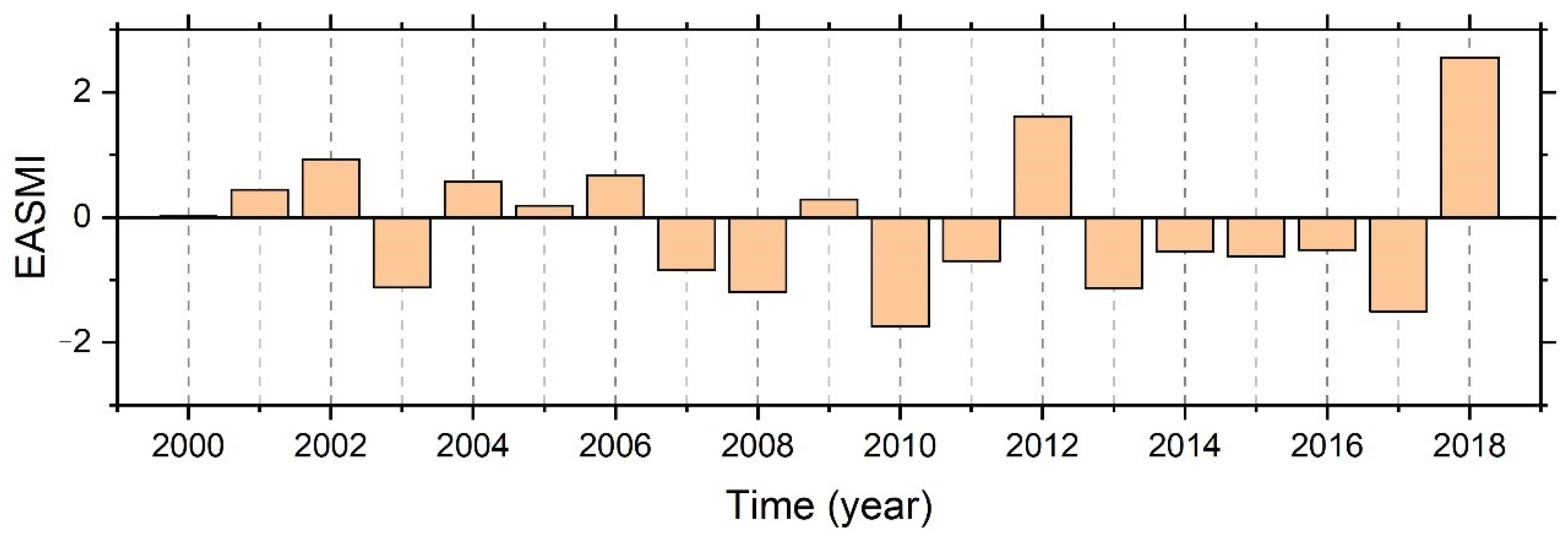
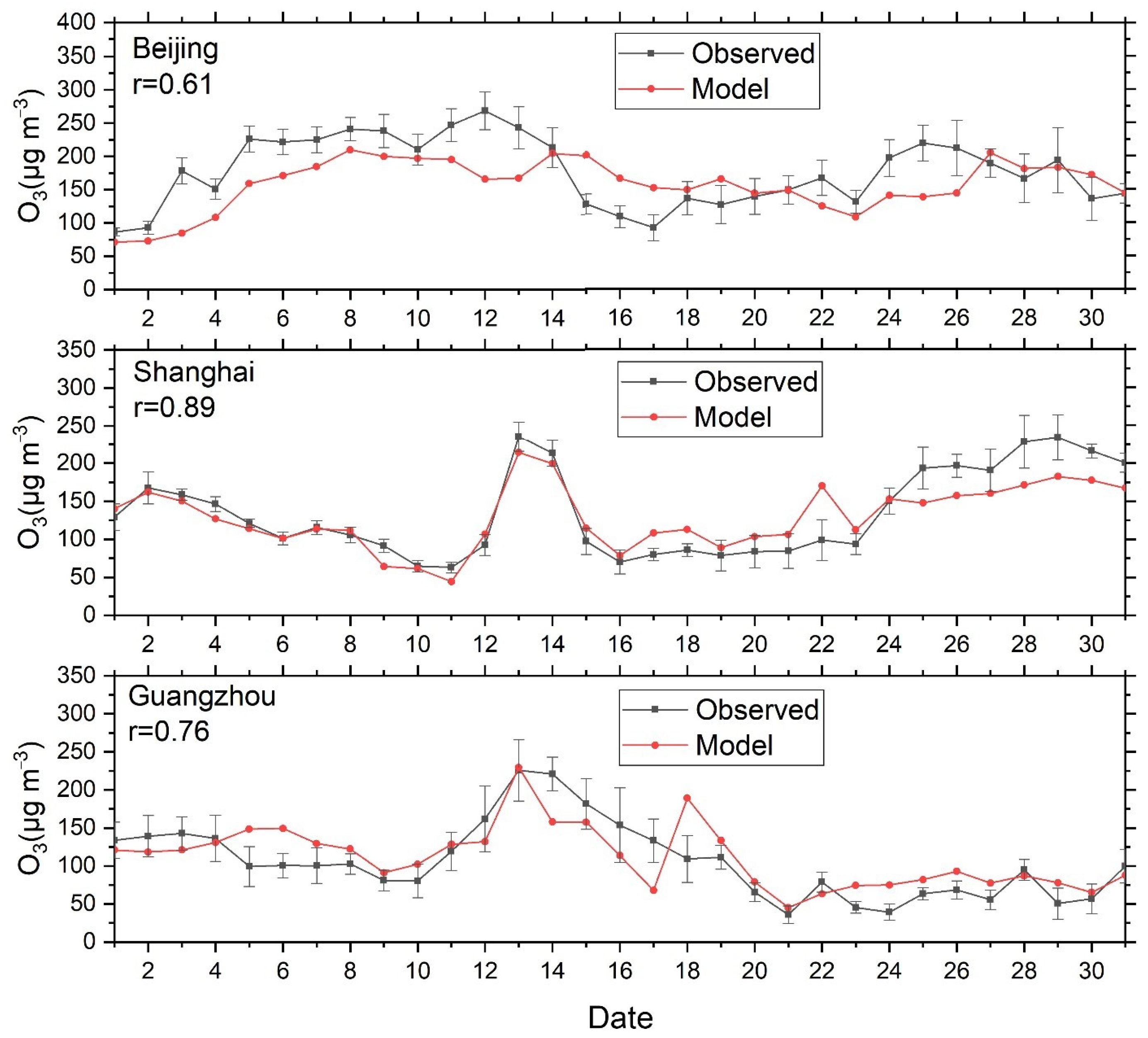
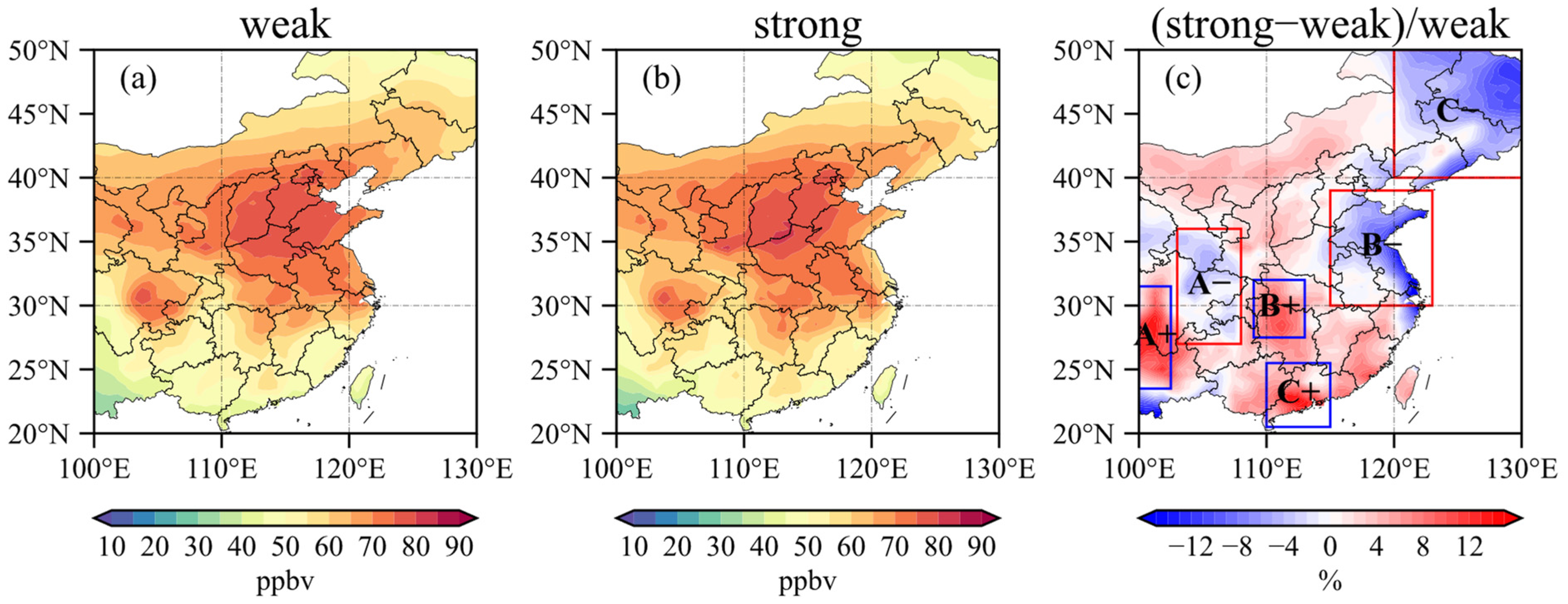
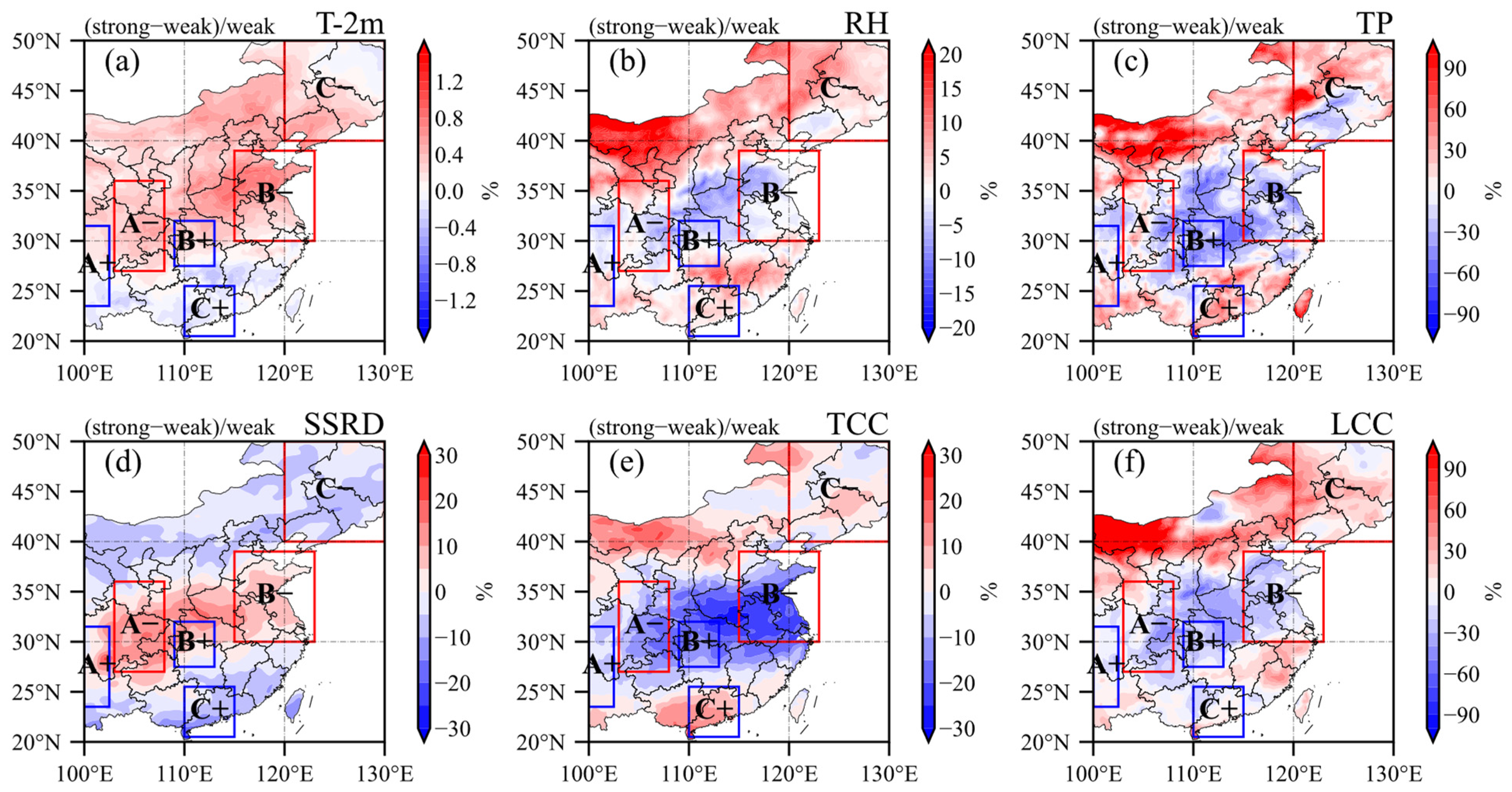
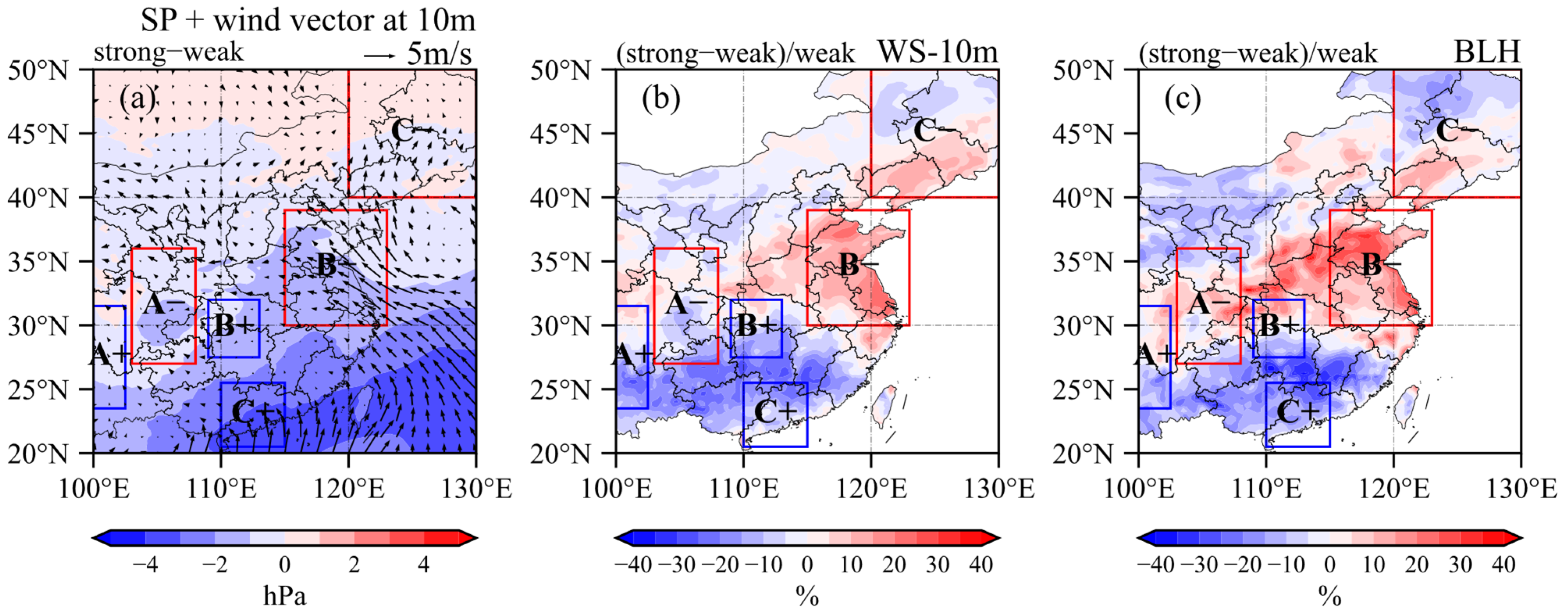
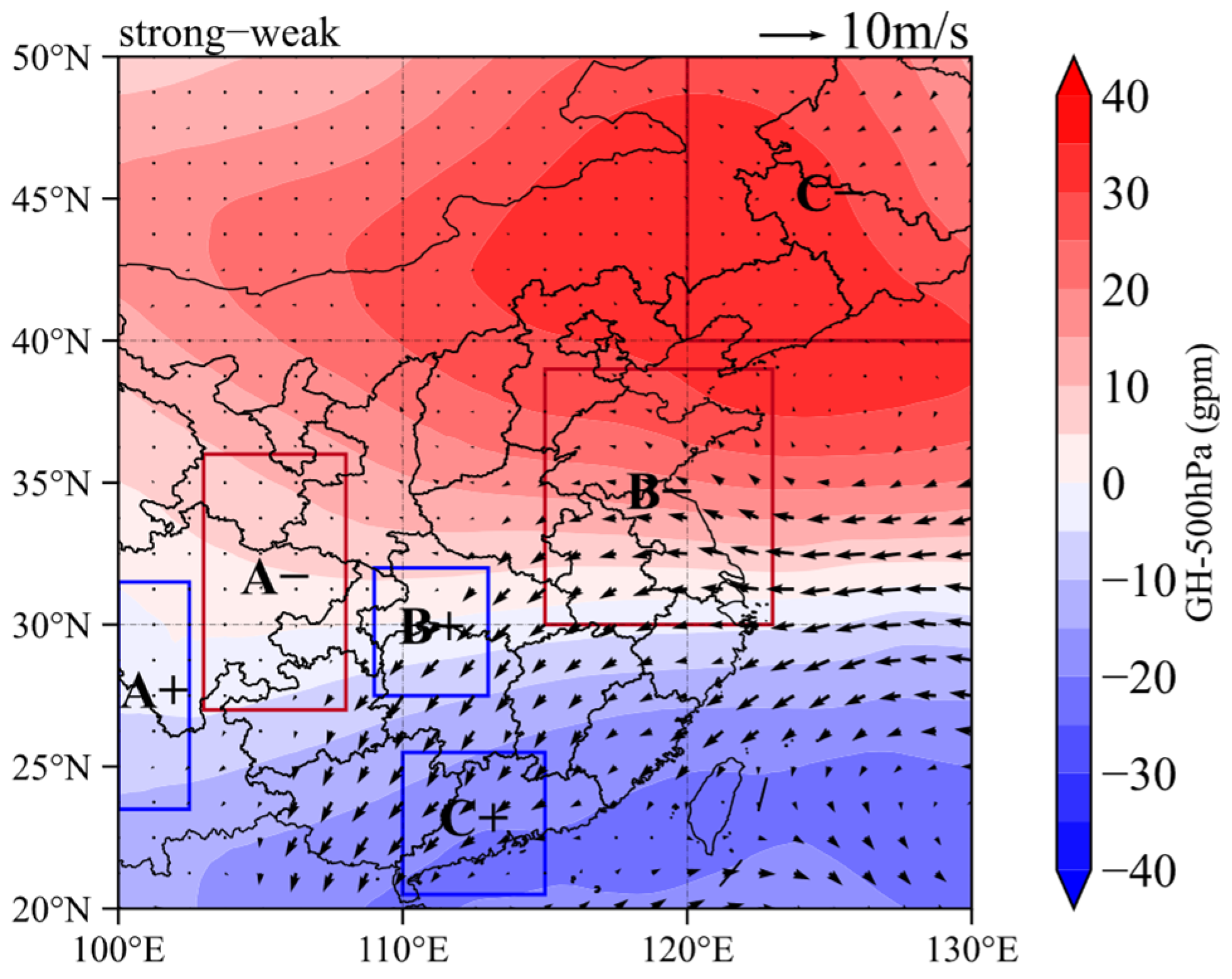
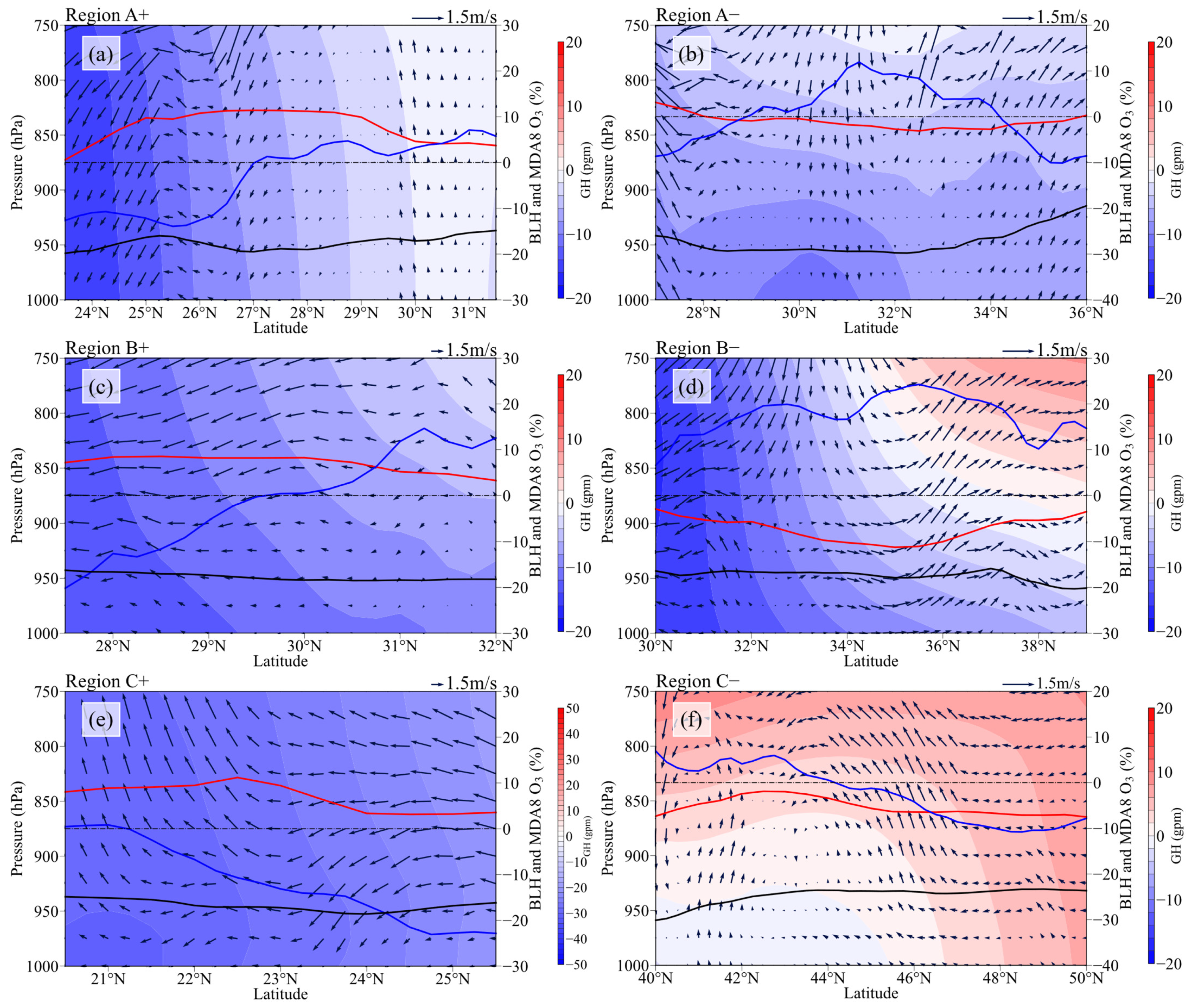
| Process Categories | Related Meteorological Variables |
|---|---|
| chemical reaction | T-2M, RH, TP, SSRD, TCC, and LCC |
| horizontal transport | SP, U-10m, V-10m, WS-10m, BLH, GH-500hPa 1, U-850hPa 1, and V-850hPa 1 |
| vertical transport | W-950hPa 1,2, W-975hPa 1,2, and W-1000hPa 1,2 |
| Region | Process Categories | Explanatory Variables | |
|---|---|---|---|
| A+ | chemical | RH + TP + TCC | 0.51 |
| horizontal | V-10m + BLH + GH-500hPa + V-850hPa | 0.37 | |
| vertical | W-975hPa + W-950hPa | 0.00 | |
| total | TCC + LCC + SP + U-10m + BLH + GH-500hPa + U-850hPa + W-950hPa | 0.76 | |
| B+ | chemical | T-2m + TP + SSRD + TCC | 0.42 |
| horizontal | V-10m + GH-500hPa + U-850hPa | 0.39 | |
| vertical | W-1000hPa + W-975hPa + W-950hPa | 0.03 | |
| total | RH + LCC + U-10m + WS-10m + BLH + GH-500hPa + V-850hPa | 0.72 | |
| C+ | chemical | RH + TP | 0.26 |
| horizontal | U-10m + GH-500hPa + U-850hPa + V-850hPa | 0.56 | |
| vertical | W-975hPa | 0.46 | |
| total | T-2m + RH + TCC + SP + U-10m + WS-10m + BLH + GH-500hPa + U-850hPa + W-1000hPa | 0.71 | |
| A− | chemical | T-2m + TP + SSRD + TCC + LCC | 0.46 |
| horizontal | V-10m + WS-10m + BLH + V-850hPa | 0.05 | |
| vertical | W-1000hPa + W-975hPa | 0.00 | |
| total | T-2m + RH + SSRD + TCC + LCC + V-10m + WS-10m + V-850hPa + W-975hPa | 0.68 | |
| B− | chemical | T-2m + RH + SSRD | 0.69 |
| horizontal | U-10m + V-10m + BLH + U-850hPa + V-850hPa | 0.67 | |
| vertical | W-1000hPa + W-950hPa | 0.28 | |
| total | RH + TP + SP + U-10m + V-10m + BLH + U-850hPa + W-1000hPa + W-975hPa + W-950hPa | 0.79 | |
| C− | chemical | T-2m + RH + SSRD + LCC | 0.68 |
| horizontal | U-10m + WS-10m + BLH + GH-500hPa + U-850hPa | 0.71 | |
| vertical | W-975hPa | 0.18 | |
| total | RH + TP + U-850hPa + W-950hPa | 0.75 |
| A+ | B+ | C+ | A− | B− | C− | |
|---|---|---|---|---|---|---|
| MDA8 O3 | 7.72 | 6.92 | 6.88 | −1.02 | −7.19 | −5.33 |
| T-2m | 0.06 | 0.22 | −0.08 | 0.30 | 0.45 | 0.19 |
| RH | 0.31 | −0.91 | 2.34 | −0.05 | −1.18 | 3.65 |
| TP | 7.19 | −34.29 | 42.24 | −6.66 | −18.68 | 14.94 |
| SSRD | 3.20 | 5.61 | −8.59 | 8.35 | 4.70 | −4.55 |
| TCC | −3.27 | −15.19 | 10.27 | −9.35 | −16.79 | 0.62 |
| LCC | −2.04 | −21.63 | 5.25 | −13.27 | −15.62 | 14.65 |
| A+ | B+ | C+ | A− | B− | C− | |
|---|---|---|---|---|---|---|
| MDA8 O3 | 7.72 | 6.92 | 6.88 | −1.02 | −7.19 | −5.33 |
| SP | −0.07 | −0.12 | −0.31 | −0.08 | −0.12 | 0.01 |
| U-10m | −19.62 | −10.08 | 906 | 73.13 | 175.59 | −2.81 |
| V-10m | 15.78 | −114.89 | −60.65 | 0.76 | −7.25 | 48.5 |
| WS-10m | −8.42 | −7.57 | −7.25 | −4.62 | 12.86 | 1.21 |
| BLH | −2.9 | −1.01 | −11.82 | 0.57 | 17.54 | −2.34 |
| GH-500hPa | −0.07 | −0.03 | −0.32 | 0.06 | 0.27 | 0.51 |
| U-850hPa | 33.24 | −196.81 | −202.17 | 269.72 | 229.43 | −9.41 |
| V-850hPa | −30.66 | −71.55 | −36.79 | 93.88 | 13.36 | −42.44 |
| A+ | B+ | C+ | A− | B− | C− | |
|---|---|---|---|---|---|---|
| MDA8 O3 | 7.72 | 6.92 | 6.88 | −1.02 | −7.19 | −5.33 |
| W-950hPa | −25.68 | 53.40 | −125.69 | −3.52 | −413.15 | −47.08 |
| W-975hPa | −14.14 | 9.44 | −81.76 | −24.87 | 549.37 | −9.38 |
| W-1000hPa | 13.24 | −11.39 | −50.35 | −13.72 | 11.83 | −244.81 |
Disclaimer/Publisher’s Note: The statements, opinions and data contained in all publications are solely those of the individual author(s) and contributor(s) and not of MDPI and/or the editor(s). MDPI and/or the editor(s) disclaim responsibility for any injury to people or property resulting from any ideas, methods, instructions or products referred to in the content. |
© 2023 by the authors. Licensee MDPI, Basel, Switzerland. This article is an open access article distributed under the terms and conditions of the Creative Commons Attribution (CC BY) license (https://creativecommons.org/licenses/by/4.0/).
Share and Cite
Zhang, X.; Zhou, L.; Zhang, X.; Luo, Y.; Sun, L. A Case Study on the Impact of East Asian Summer Monsoon on Surface O3 in China. Atmosphere 2023, 14, 768. https://doi.org/10.3390/atmos14050768
Zhang X, Zhou L, Zhang X, Luo Y, Sun L. A Case Study on the Impact of East Asian Summer Monsoon on Surface O3 in China. Atmosphere. 2023; 14(5):768. https://doi.org/10.3390/atmos14050768
Chicago/Turabian StyleZhang, Xin, Lihua Zhou, Xingying Zhang, Yong Luo, and Lei Sun. 2023. "A Case Study on the Impact of East Asian Summer Monsoon on Surface O3 in China" Atmosphere 14, no. 5: 768. https://doi.org/10.3390/atmos14050768
APA StyleZhang, X., Zhou, L., Zhang, X., Luo, Y., & Sun, L. (2023). A Case Study on the Impact of East Asian Summer Monsoon on Surface O3 in China. Atmosphere, 14(5), 768. https://doi.org/10.3390/atmos14050768








